Experimental Analysis of Continuous Beams Made of Self-Compacting Concrete (Scc) Strengthened with Fiber Reinforced Polymer (Frp) Materials
Abstract
1. Introduction
2. Experimental Program
2.1. Test Specimens
2.2. Mechanical Properties of Materials
2.2.1. Mechanical Properties of SCC Concrete
2.2.2. Mechanical Properties of Steel, FRP Reinforcement and Epoxy Adhesive
2.3. Methods of Strengthening of RC Beams
2.3.1. NSM Strengthening Method
- A groove is formed with the help of a saw with a diamond blade according to the dimensions depending on the diameter of the bar. Based on recommendations in the literature [31], the groove dimensions were two and a half times larger than the diameter of the mounted bars. Thus, in the case of GFRP bars (Ø10) the groove measured 25 × 25 mm, while in the case of CFRP bars (Ø8) it was 20 × 20.
- Two-component epoxy adhesive is applied to half the depth of the groove, after which a glass or carbon FRP bar is mounted.
- Finally, the epoxy adhesive fills the rest of the groove, whereby the surface of the concrete beam remains visually identical to the surface of the unstrengthened beam.
2.3.2. EB Strengthening Method
- Firstly, the tapes, having the factory size of 50×1.2 mm, were tailored to the required width of 38 mm for the purpose of achieving the identical axial stiffness as the CFRP bar, having diameter of Ø8 mm.
- The surfaces of the beam were sound and without irregularities so there was no need for additional processing before installing the FRP tapes.
- The surfaces of the beam were cleaned to remove dust, after which the surfaces were impregnated with primer.
- FRP tape was also cleaned with appropriate cleaner. The solvent was evaporated and the surface of the tapes was completely dry before the application of the adhesive.
- Two-component epoxy adhesive is applied in a thickness of approximately 1 mm on both the FRP tape and the surface of the RC beam.
- The roller expels air bubbles and removes excess epoxy adhesive on both sides of the FRP tapes.
2.3.3. Variants of Strengthening of Tested Beams
- B-Con—Beam Control: Control (unstrengthened) beam;
- B-G1—Beam Glass 1: Beam strengthened with GFRP bar in the negative moment zone over the middle support (hogging zone);
- B-G2—Beam Glass 2: Beam strengthened with GFRP bar in the positive moment zones (sagging zones);
- B-G3—Beam Glass 3: Beam strengthened with GFRP bar in the negative moment zone above the middle support and with two GFRP reinforcement bars in the positive moment zones;
- B-C—Beam Carbon: Beam strengthened with one CFRP reinforcement bar in the negative moment zone and with two CFRP reinforcement bars in the positive moment zones;
- B-EC—Beam External Carbon: Beam strengthened with one CFRP tape in the negative moment zone and with two CFRP tapes in the positive moment zones.
2.4. Experiment Setup and the Procedure of Load Application
- Vertical displacements—deflections,
- Normal strain in concrete, steel and FRP reinforcement,
3. Results and Discussion
3.1. Analysis of Recorded Deflections
- Zone before emergence of the cracks, where the relation between the load and displacement is linear,
- Zone after emergence of the cracks, and before the yield of steel, crushing of concrete or debonding of the strengthening system, where the relationship between the load and displacement is non-linear; and
- Zone after the yield of steel, crushing of concrete or debonding of the strengthening system until the cross-section failure.
- For beams strengthened with GFRP bars, by the NSM method, the increase in load-bearing capacity was 22–67% depending on the position of the reinforcement, with the largest increase in load-bearing capacity of beam B-G3 when the strengthening is both above the middle support and in both spans of the beam.
- In the case when beams are strengthened with CFRP bars by the NSM method both above the middle support and in both spans of the continuous beam (B-C beam), the increase in load-bearing capacity is 82%.
- For beams strengthened with CFRP tapes of the same axial stiffness as CFRP bars, by the EB method (B-EC beam) the increase of the load-bearing capacity compared to the B-C beam is lower, and it amounts to 50%.
3.2. Analysis of Normal Strain in the Steel Reinforcement
3.3. Analysis of Normal Strains in the FRP Reinforcement
3.4. Analysis of Normal Strains in the Concrete
3.5. Beam Failure Modes
4. Conclusions
- The use of FRP materials in strengthening of RC continuous beams, even with a small amount of additional reinforcement, can considerably increase their load-bearing capacity. An increase of 22–82% in the load-bearing capacity of the strengthened beams compared to the control beam was achieved.
- The highest increase of the load-bearing capacity was in the beams strengthened both in the negative moment zone above the middle support and in the positive moment zones in the spans, and it ranges within 50–82% depending on the type of FRP reinforcement (glass and carbon) and the method of strengthening (EB and NSM).
- Strengthening with CFRP materials results in a higher failure load, but the price of these materials is considerably higher compared to GFRP materials so in each individual case, it should be assessed which material is more adequate.
- The use of FRP materials also influenced the increase of the yielding load which was in the range from 14% to 100% compared to the yielding load of the control beam.
- With the increase in the amount of FRP reinforcement, it is noticeable that there is a decrease in the deformability or ductility of reinforced beams, which is one of the main disadvantages of using FRP reinforcement.
- The failure modes of the strengthened beam with higher percentage of FRP reinforcement were brittle with separation of the concrete protective layer and before fully utilizing the tensile strength of the FRP material. The lowest efficiency was observed in the beam strengthened by the EB method due to the separation of the tapes.
- Debonding of the FRP system in the beams strengthened in the same manner occurred earlier with the EB method, so the efficiency and utilization of the tensile strength of the FRP reinforcement is higher with the NSM method.
- The basic disadvantages of the NSM method compared to the EB method are the groove size for installing the FRP bars and the higher price, which lead to the conclusion that the assessment of which method is more adequate should be made on a case by case basis.
Author Contributions
Funding
Institutional Review Board Statement
Informed Consent Statement
Conflicts of Interest
References
- Bilotta, A.; Ceroni, F.; di Ludovico, M.; Nigro, E.; Pecce, M.; Manfredi, G. Bond efficiency of EBR and NSM systems for strengthening concrete members. J. Compos. Constr. 2011, 15, 757–772. [Google Scholar] [CrossRef]
- ISIS Educational Module 2. An Introduction to FRP Composites for Construction; A Canadian Network of Centres of Excellence: Ottawa, ON, Canada, 2006. [Google Scholar]
- Fib, Bulletin.14 (Task Group 9.3). Externally Bonded FRP Reinforcement for RC Structures. Technical Report on the Design and Use of Externally Bonded Fiber Reinforced Polymer Reinforcement (FRP EBR) for Reinforced Concrete Structures; International Federation for Structural Concrete: Lausanne, Switzerland, 2001. [Google Scholar]
- Sakr, M.A.; Khalifa, T.M.; Mansour, W.N. External Strengthening of RC Continuous Beams Using FRP Plates: Finite Element Model. In Proceedings of the Second International Conference on Advances in Civil, Structural and Mechanical Engineering—CSM 2014, Birmingham, UK, 1–2 June 2014. [Google Scholar] [CrossRef]
- Akbarzadeh, H.; Maghsoudi, A.A. Experimental and analytical investigation of reinforced high strength concrete continuous beams strengthened with fiber reinforced polymer. Mater. Des. 2010, 31, 1130–1147. [Google Scholar] [CrossRef]
- Aiello, M.A.; Valente, L.; Rizzo, A. Moment redistribution in continuous reinforced concrete beams strengthened with carbon fiber- reinforced polymer laminates. Mech. Compos. Mater. 2007, 43, 453–466. [Google Scholar] [CrossRef]
- Maghsoudi, A.A.; Bengar, H.A. Moment redistribution and ductility of RHSC continuous beams strengthened with CFRP. Turk. J. Eng. Environ. Sci. 2009, 33, 45–59. [Google Scholar]
- Rahman, M.M.; Jumaat, M.Z. The Effect of CFRP Laminate Length for Strengthening the Tension Zone of the Reinforced Concrete T-Beam. J. Sci. Res. Rep. 2013, 2, 626–640. [Google Scholar] [CrossRef]
- Al-Khafaji, A.; Salim, H. Flexural Strengthening of RC Continuous T-Beams Using CFRP. Fibers 2020, 8, 41. [Google Scholar] [CrossRef]
- Soumya, S. Strengthening of RC Continuous Beam Using FRP Sheet; Department of Civil Engineering, National Institute of Technology Rourkela: Odisha, India, 2012. [Google Scholar]
- Wang, X.; Zhou, C. Numerical investigation for the flexural strengthening of reinforced concrete beams with external prestressed HFRP sheets. Constr. Build. Mater. 2018, 804–815. [Google Scholar] [CrossRef]
- Wang, X.; Zhou, C.; Ai, J.; Petru, M.; Liu, Y. Numerical investigation for the fatigue performance of reinforced concrete beams strengthened with external prestressed HFRP sheet. Constr. Build. Mater. 2020, 237, 117601. [Google Scholar] [CrossRef]
- Zhang, C.; Wang, J. Viscoelastic analysis of FRP strengthened reinforced concrete beams. Compos. Struct. 2011, 93, 3200–3208. [Google Scholar] [CrossRef]
- Aidoo, J.; Harries, K.A.; Petrou, M.F. Full-scale experimental investigation of repair of reinforced concrete interstate bridge using CFRP materials. J. Bridge Eng. 2006, 11, 350–358. [Google Scholar] [CrossRef]
- Quattlebaum, J.B.; Harries, K.A.; Petrou, M.F. Comparison of three flexural retrofit systems under monotonic and fatigue loads. J. Bridge Eng. 2005, 10, 731–740. [Google Scholar] [CrossRef]
- Rosenboom, O.A.; Rizkalla, S. Fatigue behavior of prestressed concrete bridge girders strengthened with various CFRP systems. ASCE J. Compos. Constr. 2007, 230, 764–776. [Google Scholar]
- Okamura, H.; Ozawa, K. Mix Design for Self-Compacting Concrete, Concrete. Libr. Jpn. Soc. Civ. Eng. 1995, 25, 107–120. [Google Scholar]
- Persson, B. A comparison between mechanical properties of self-compacting concrete and the corresponding properties of normal concrete. Cem. Concr. Res. 2001, 31, 193–198. [Google Scholar] [CrossRef]
- Okamura, H.; Ouchi, M. Self-Compacting Concrete. J. Adv. Concr. Technol. 2003, 5, 5–15. [Google Scholar] [CrossRef]
- Domone, P.L. A review of the hardened mechanical properties of self-compacting concrete. Cem. Concr. Compos. 2007, 1–12. [Google Scholar] [CrossRef]
- Aslani, F.; Nejadi, S. Mechanical properties of conventional and self-compacting concrete: An analytical study. Constr. Build. Mater. 2012, 36, 330–347. [Google Scholar] [CrossRef]
- Vidivelli, B.; Kathiravan, T.; Gobi, T. Flexural Behaviour of Self Compacting and Self Curing Concrete Beams. Asian Rev. Civ. Eng. 2013, 2, 1–9. [Google Scholar]
- Shi, C.; Wu, Z.; Lv, K.; Wu, L. A review on mixture design methods for self-compacting concrete. Constr. Build. Mater. 2015, 84, 387–398. [Google Scholar] [CrossRef]
- Khatab, T.A.M.; Ashour, F.A.; Sheehan, T.; Lam, D. Experimental investigation on continuous reinforced SCC deep beams and Comparisons with Code provisions and models. Eng. Struct. 2017, 131, 264–274. [Google Scholar] [CrossRef]
- Petrović, Ž.; Milošević, B.; Zorić, A.; Ranković, S.; Mladenović, B.; Zlatkov, D. Flexural Behavior of Continuous Beams Made of Self-Compacting Concrete (SCC)—Experimental and Numerical Analysis. Appl. Sci. 2020, 10, 8654. [Google Scholar] [CrossRef]
- European Commitee for Standardization. Eurocode 2. Design of Concrete Structures–Part 1-1: General Rules and Rules for Buildings; European Commitee for Standardization: Brussels, Belgium, 2004. [Google Scholar]
- EFNARC. The European Guidelines for Self-Compacting Concrete Specification; Production and Use; EFNARC: Farham, UK, 2005; p. 66. [Google Scholar]
- European Commitee for Standardization. EN 206-9:2010. Additional Rules for Self-Compacting Concrete (SCC); European Commitee for Standardization: Brussels, Belgium, 2010; p. 27. [Google Scholar]
- Ranković, S. Experimental and Theoretical Analysis of Limit State RC Linear Plane Structures Strengthened with NSM FRP Elements. Ph.D. Thesis, University of Niš, Niš, Serbia, 2011. [Google Scholar]
- ACI 440.3R-04. Guide Test Methods for Fiber-Reinforced Polymers (FRPs) for Reinforcing or Strengthening Concrete Structures; ACI Committee 440; American Concrete Institute: Farmington, Hills, MI, USA, 2004; p. 16. [Google Scholar]
- Hassan, T.K.; Rizkalla, S.H. Bond Mechanism of Near-Surface-Mounted Fiber-Reinforced Polymer Bars for Flexural Strengthening of Concrete Structures. ACI Struct. J. 2004, 101, 830–839. [Google Scholar]
- Grelle, S.V.; Sneed, L.H. Review of Anchorage Systems for Externally Bonded FRP Laminates. Int. J. Cocnr. Struct. Mater. 2013, 7, 17–33. [Google Scholar] [CrossRef]
- Petrović, Ž. Experimental—Theoretical Analysis of Limit States of Continuous Beams Made of Self-Compacting Concrete Strengthened with Fiber Reinforced Polymer (FRP). Ph.D. Thesis, University of Niš, Niš, Serbia, 2016. [Google Scholar]

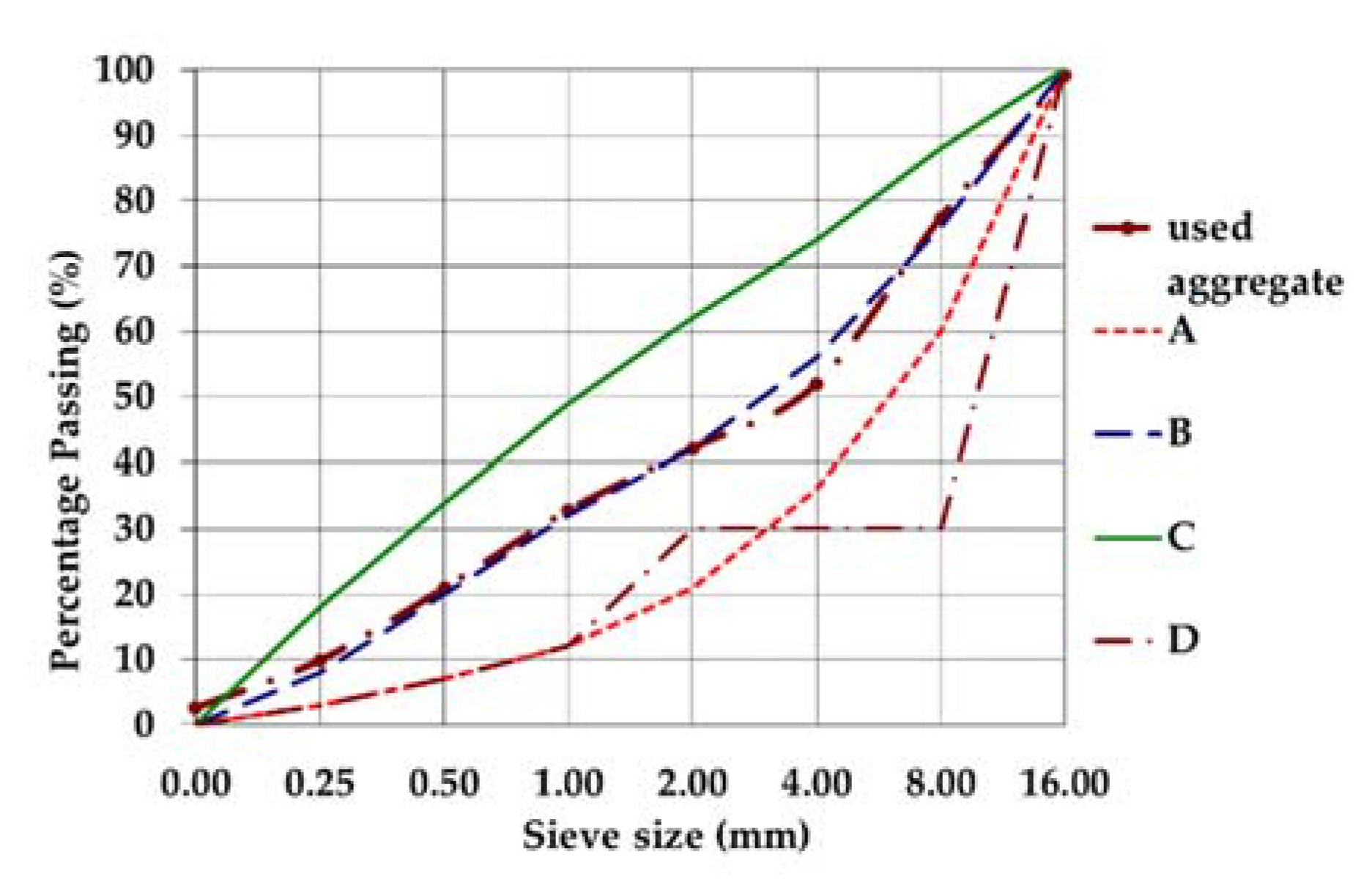
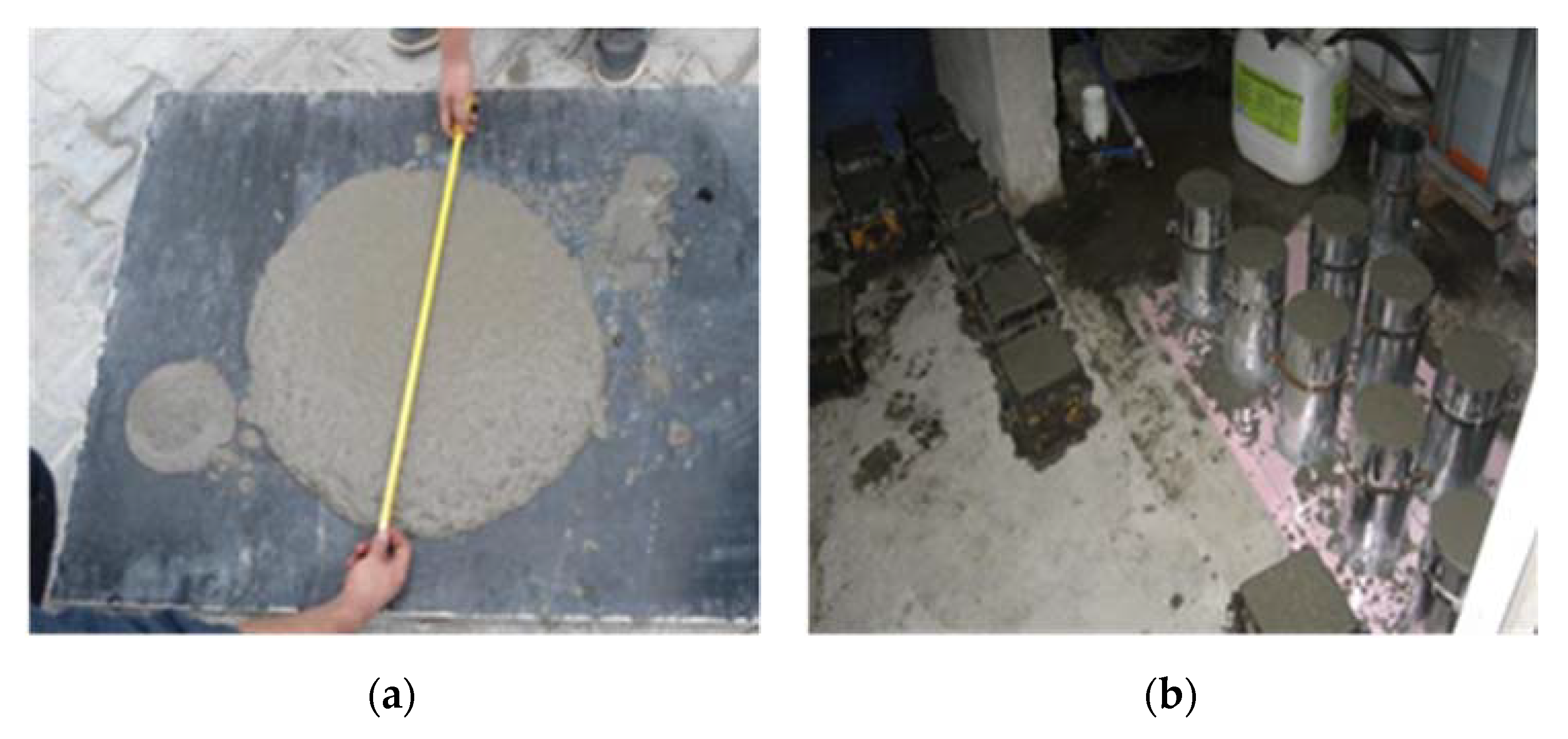
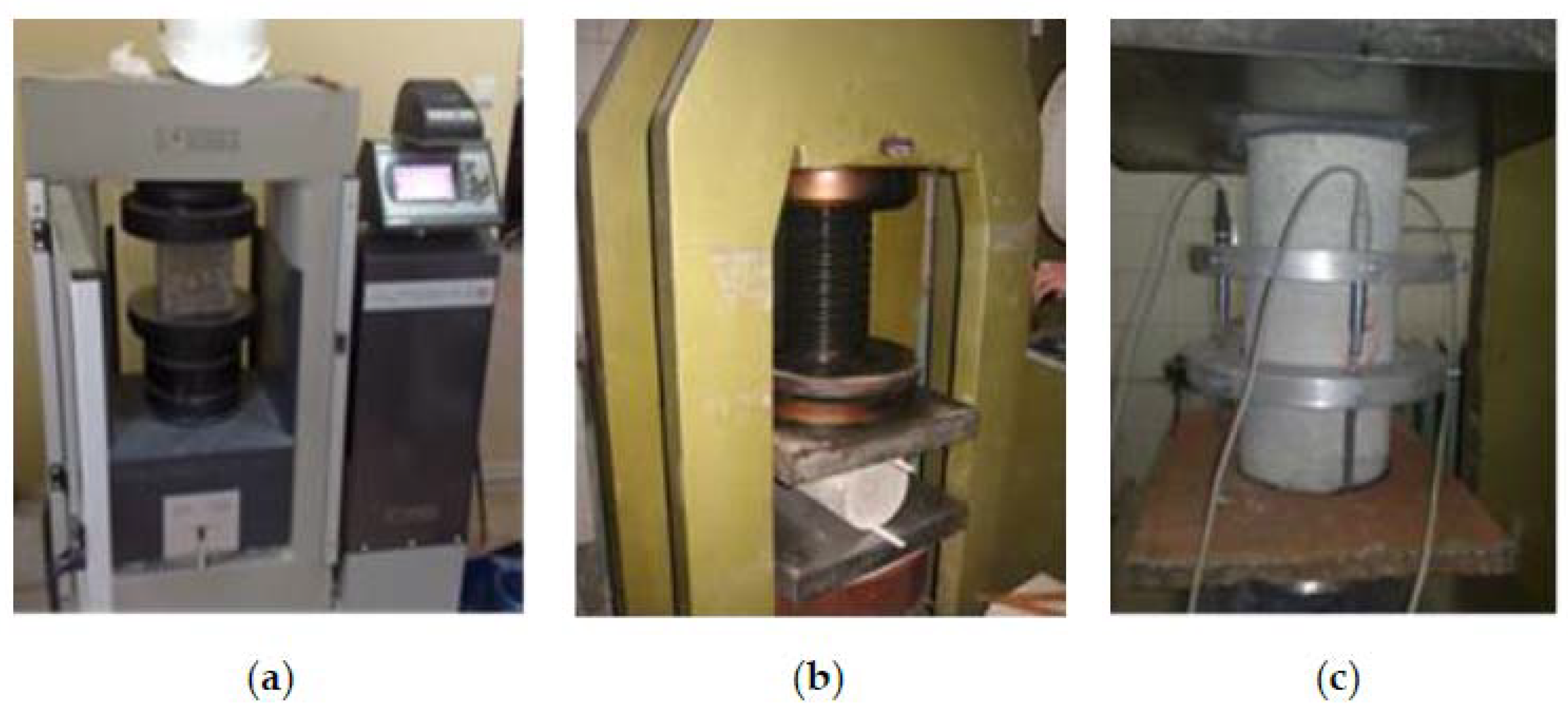
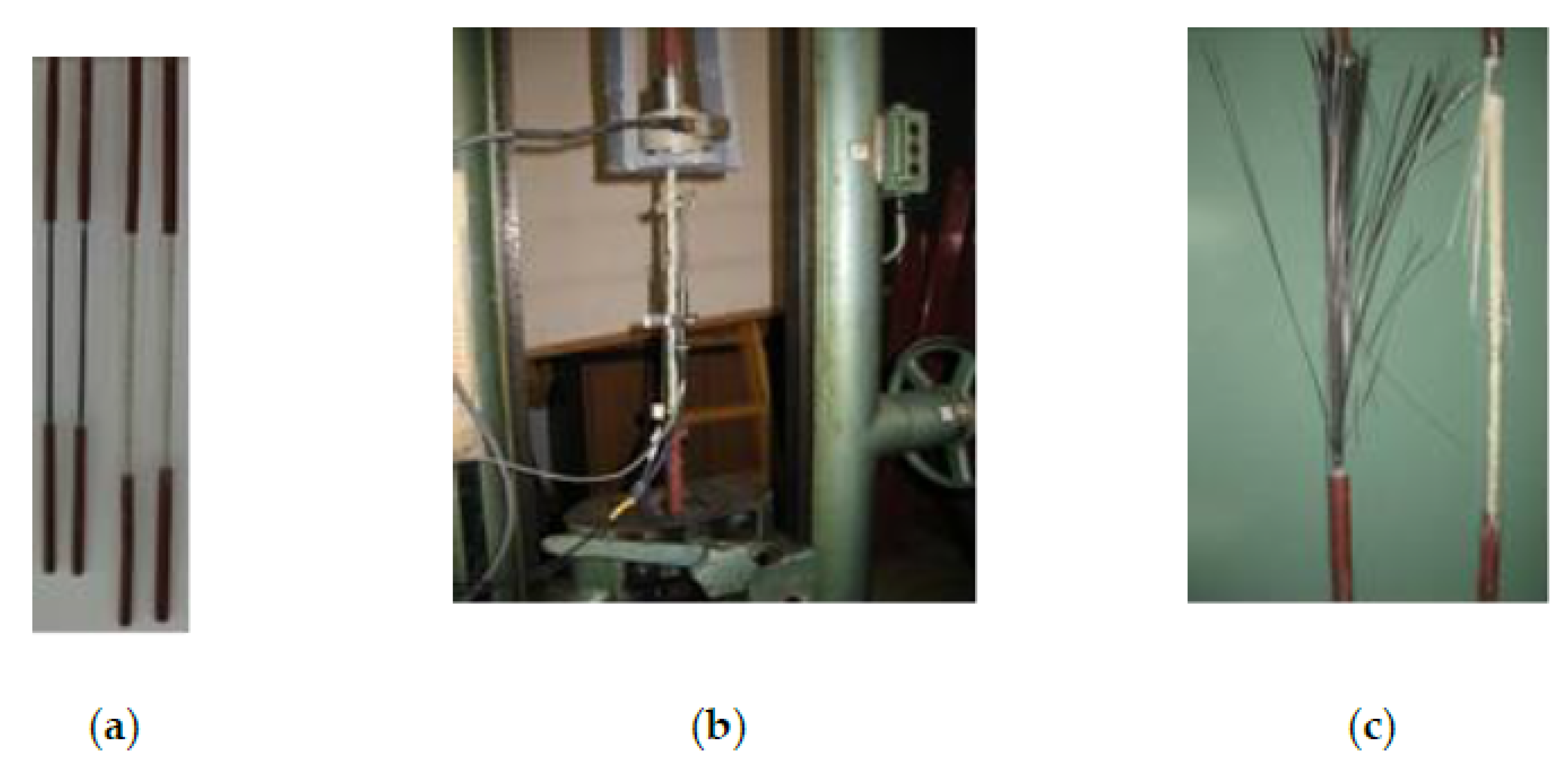
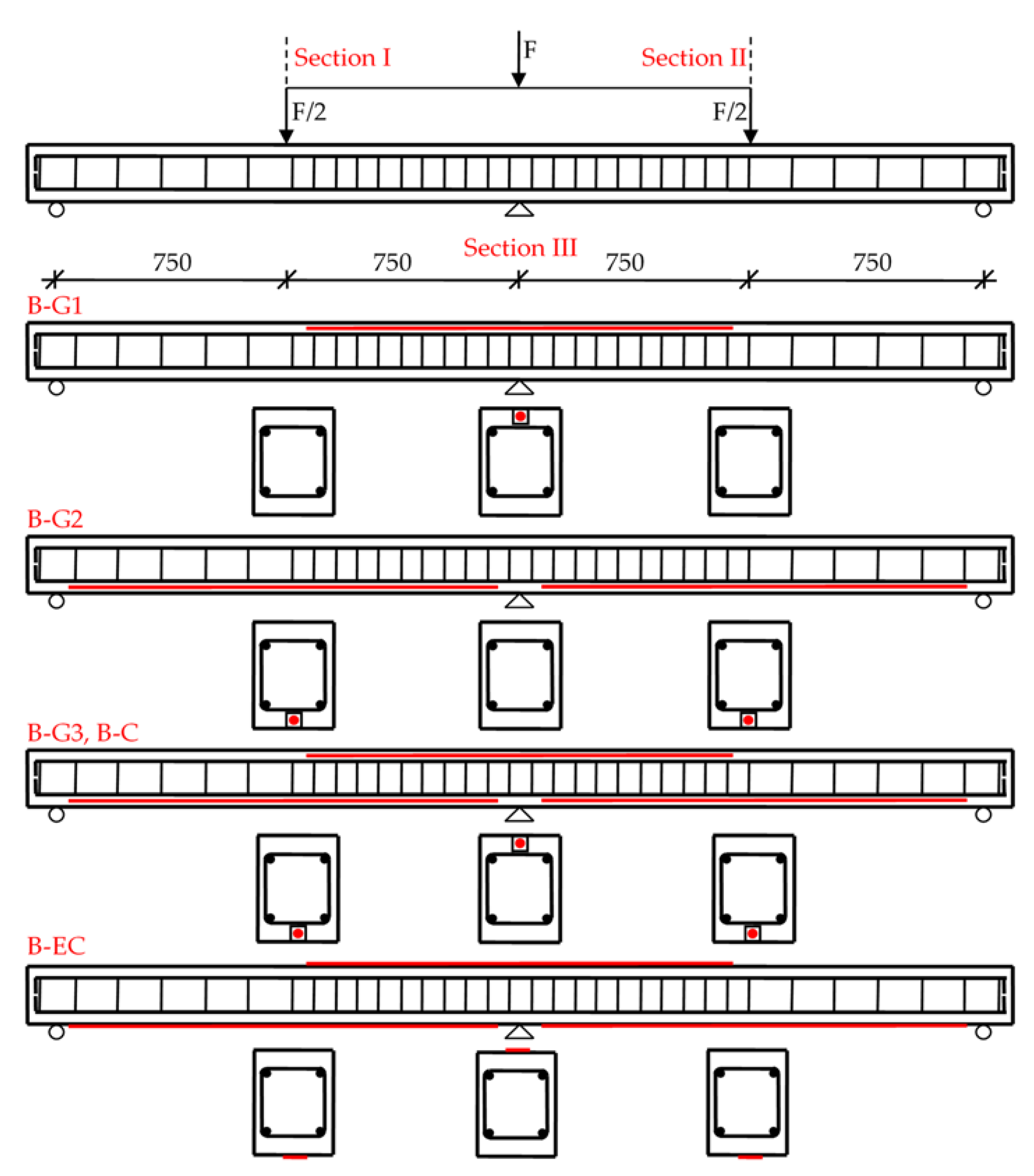

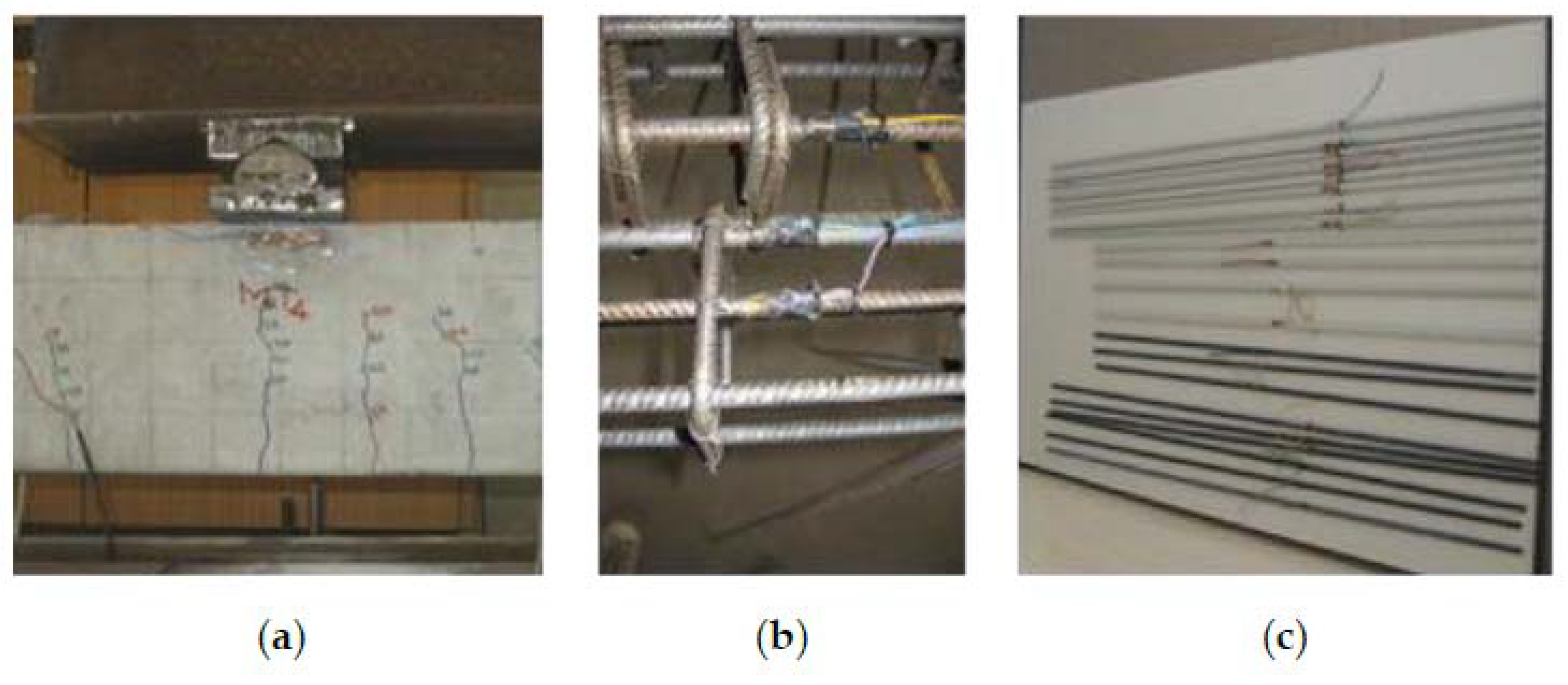
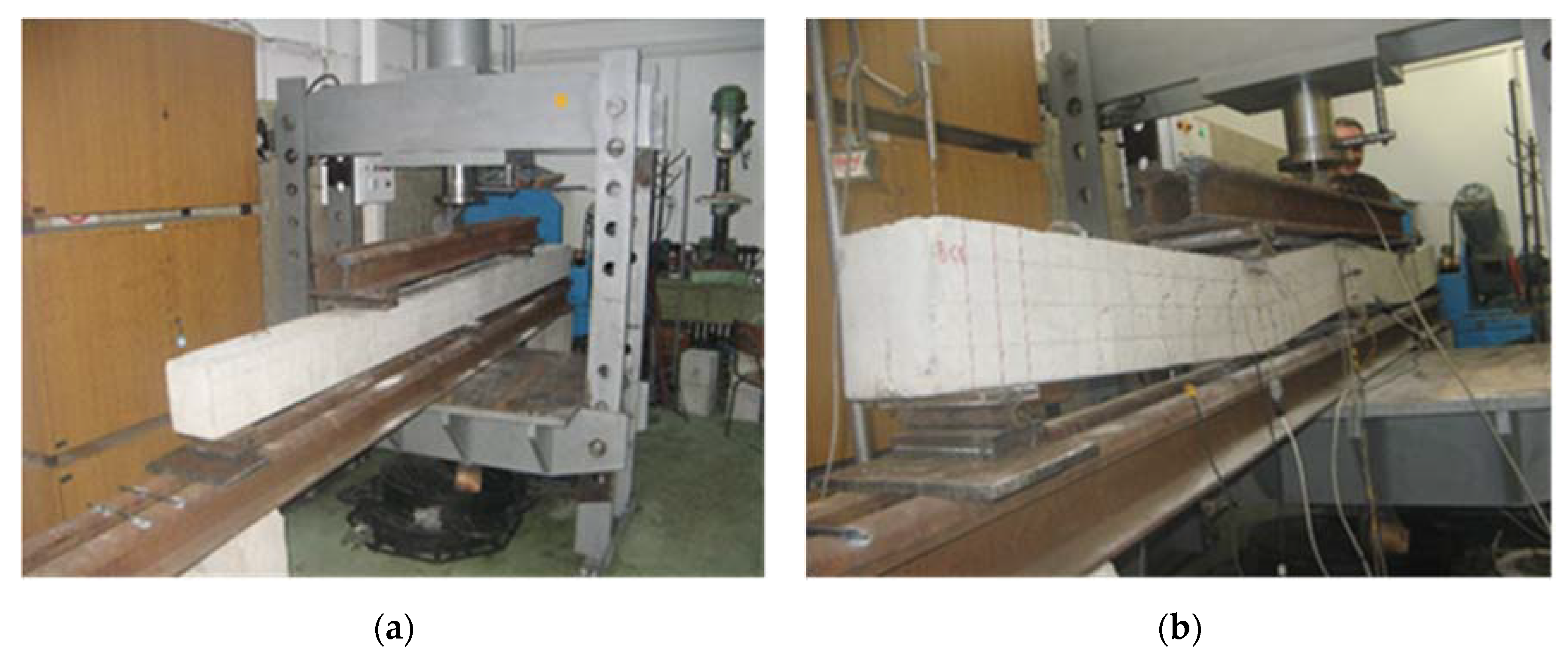
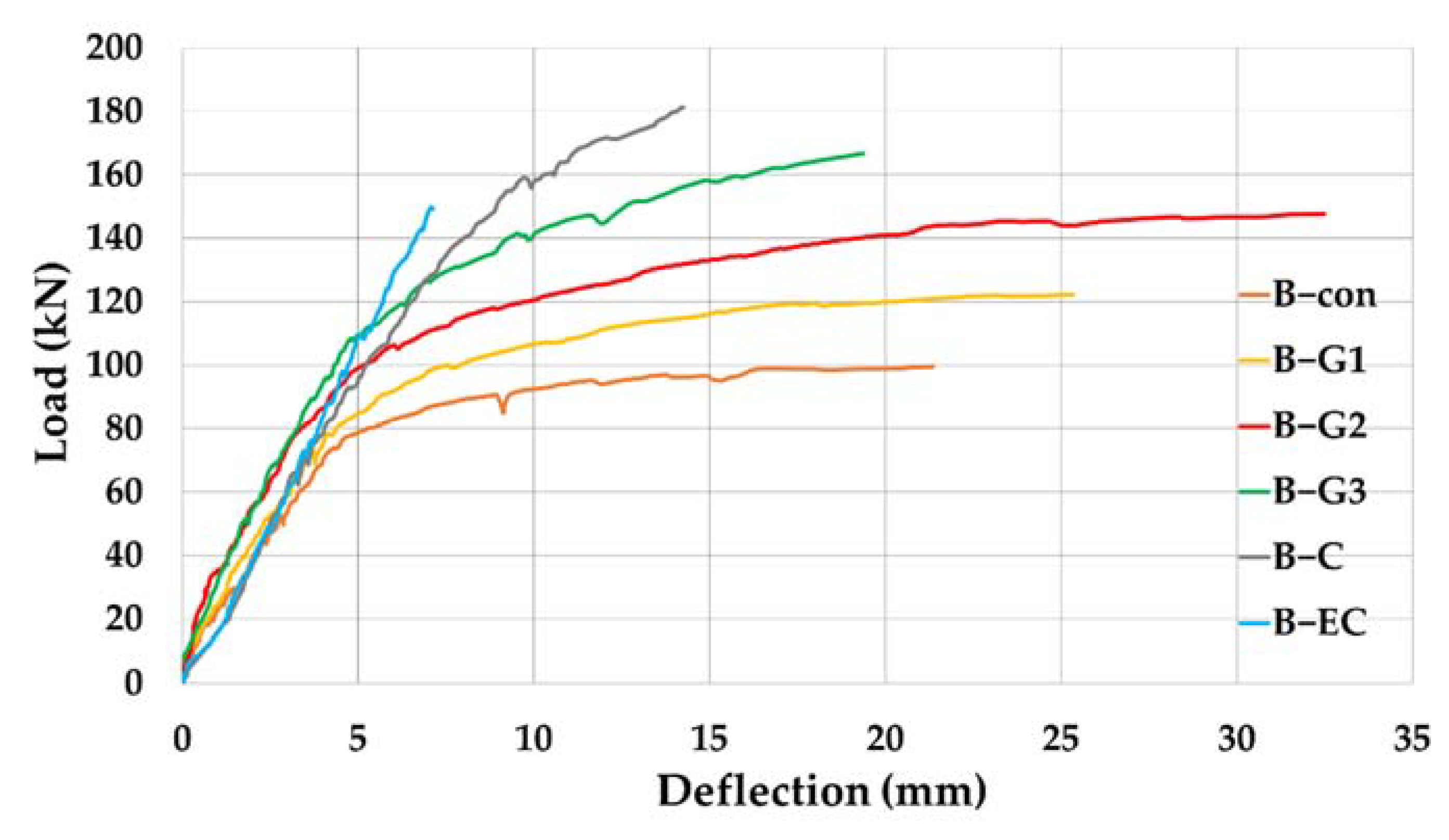
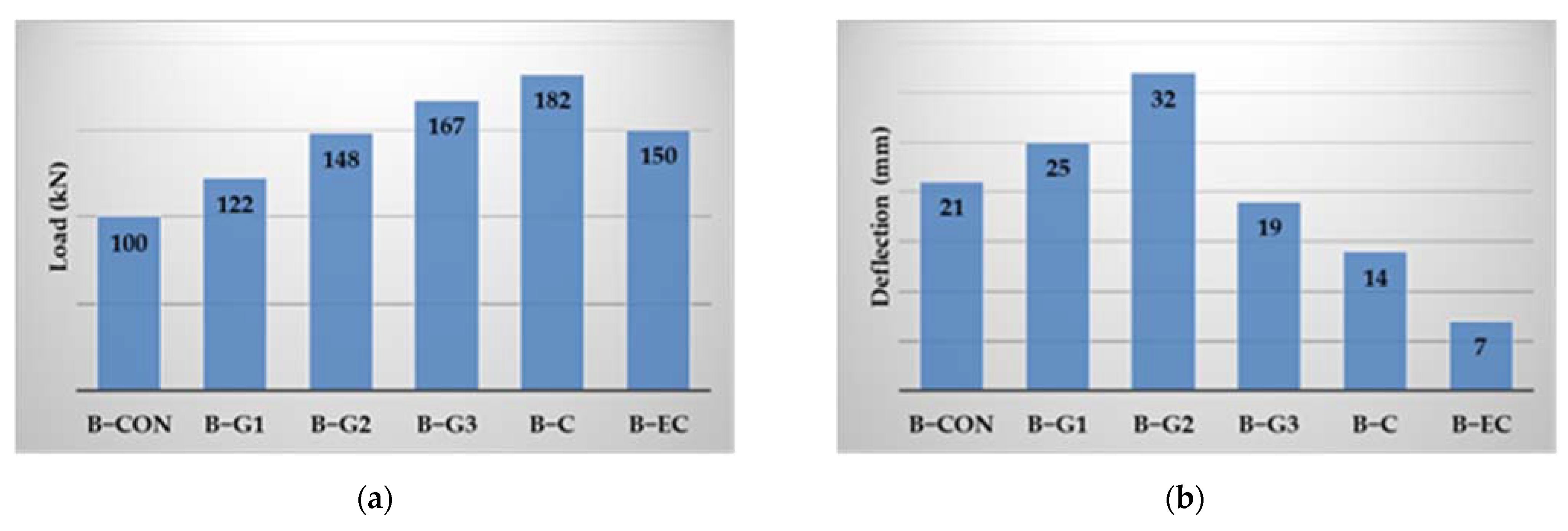
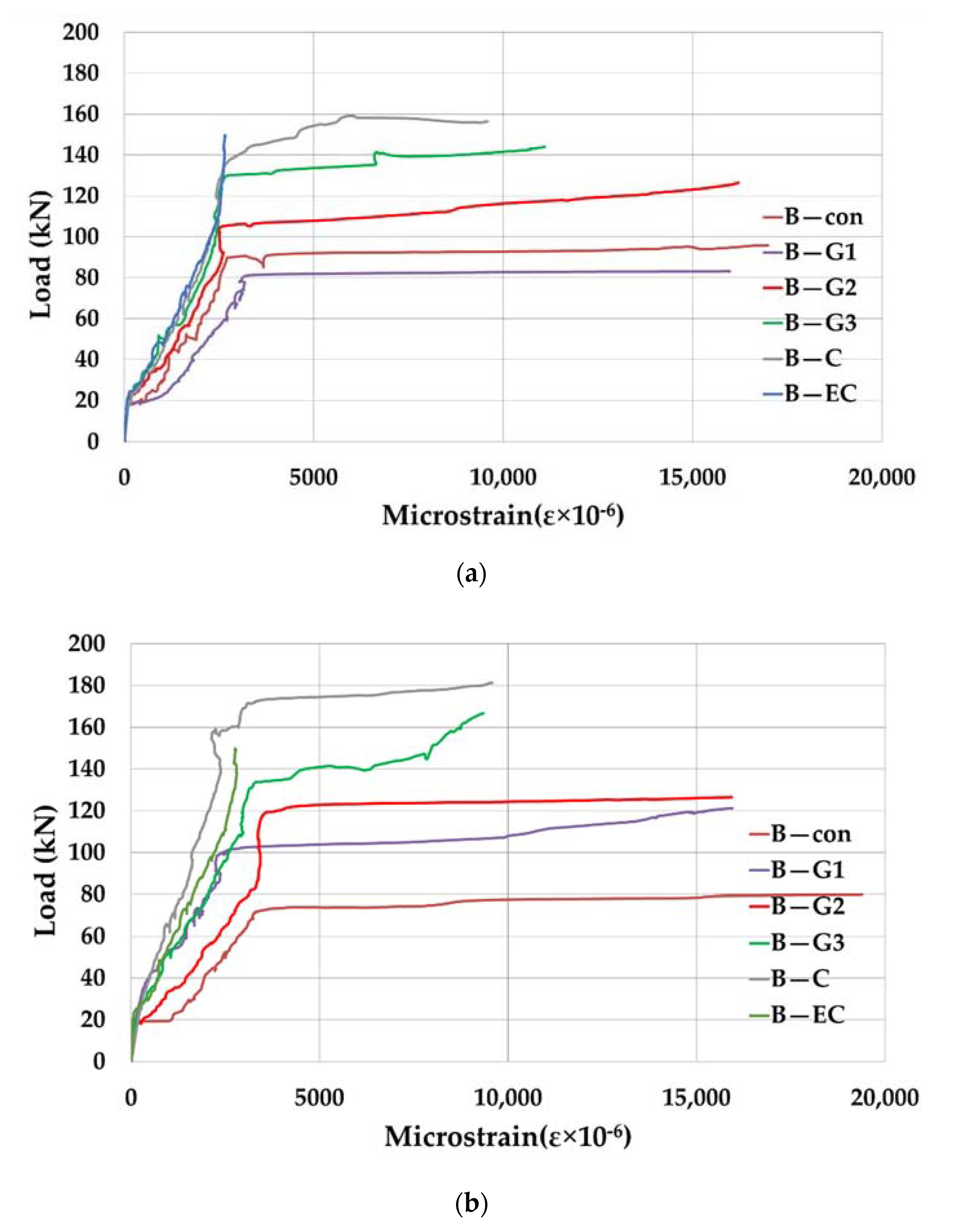
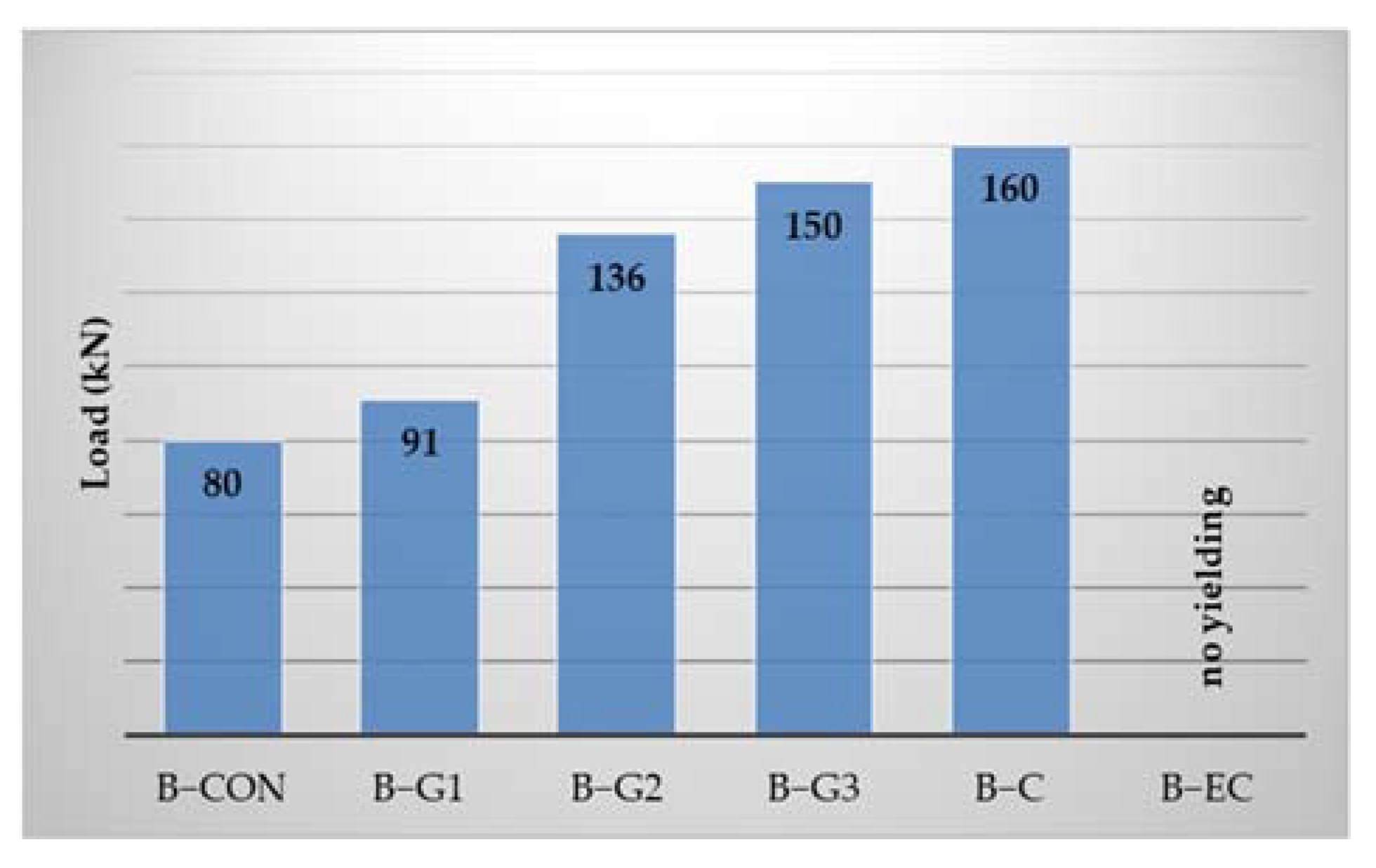
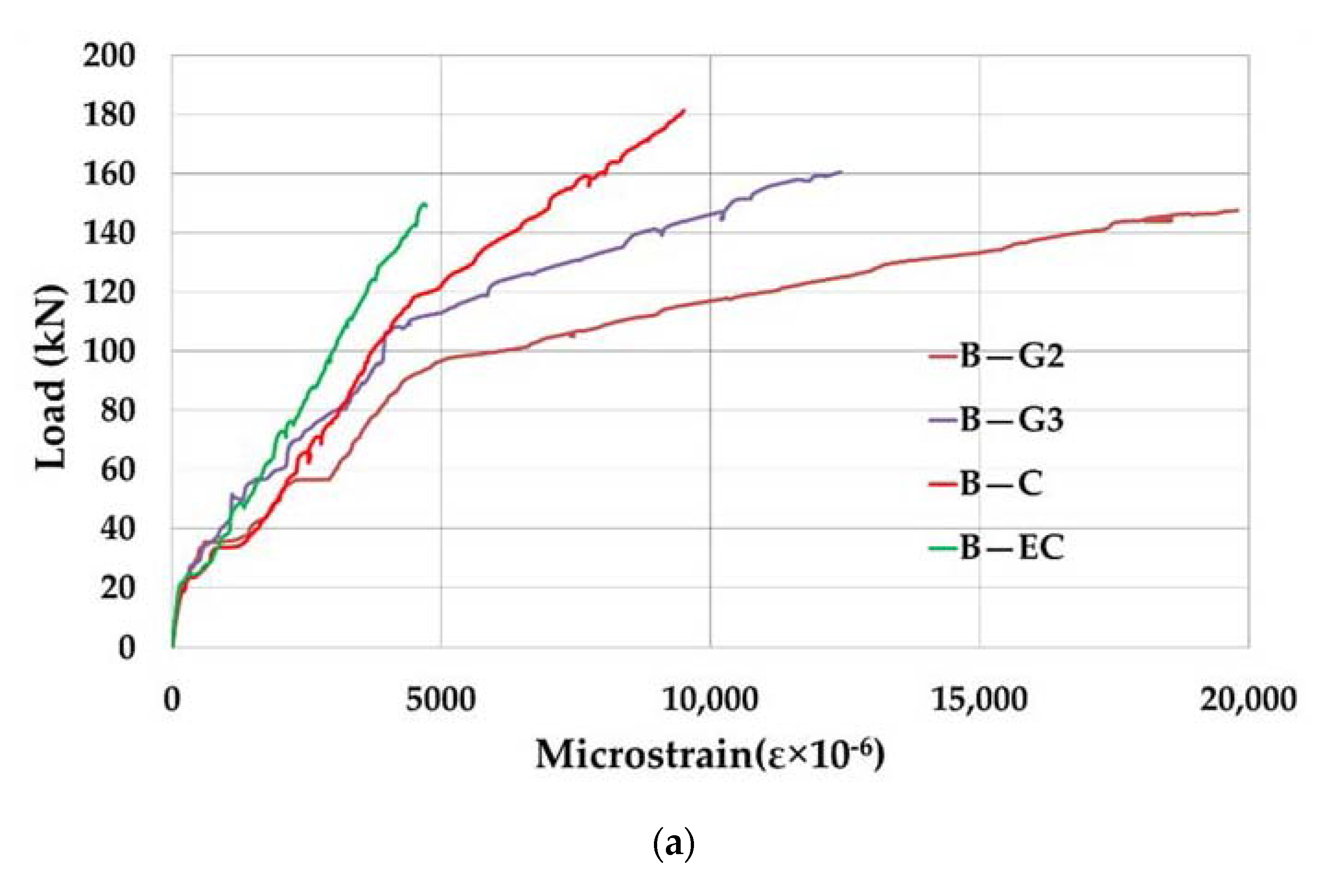
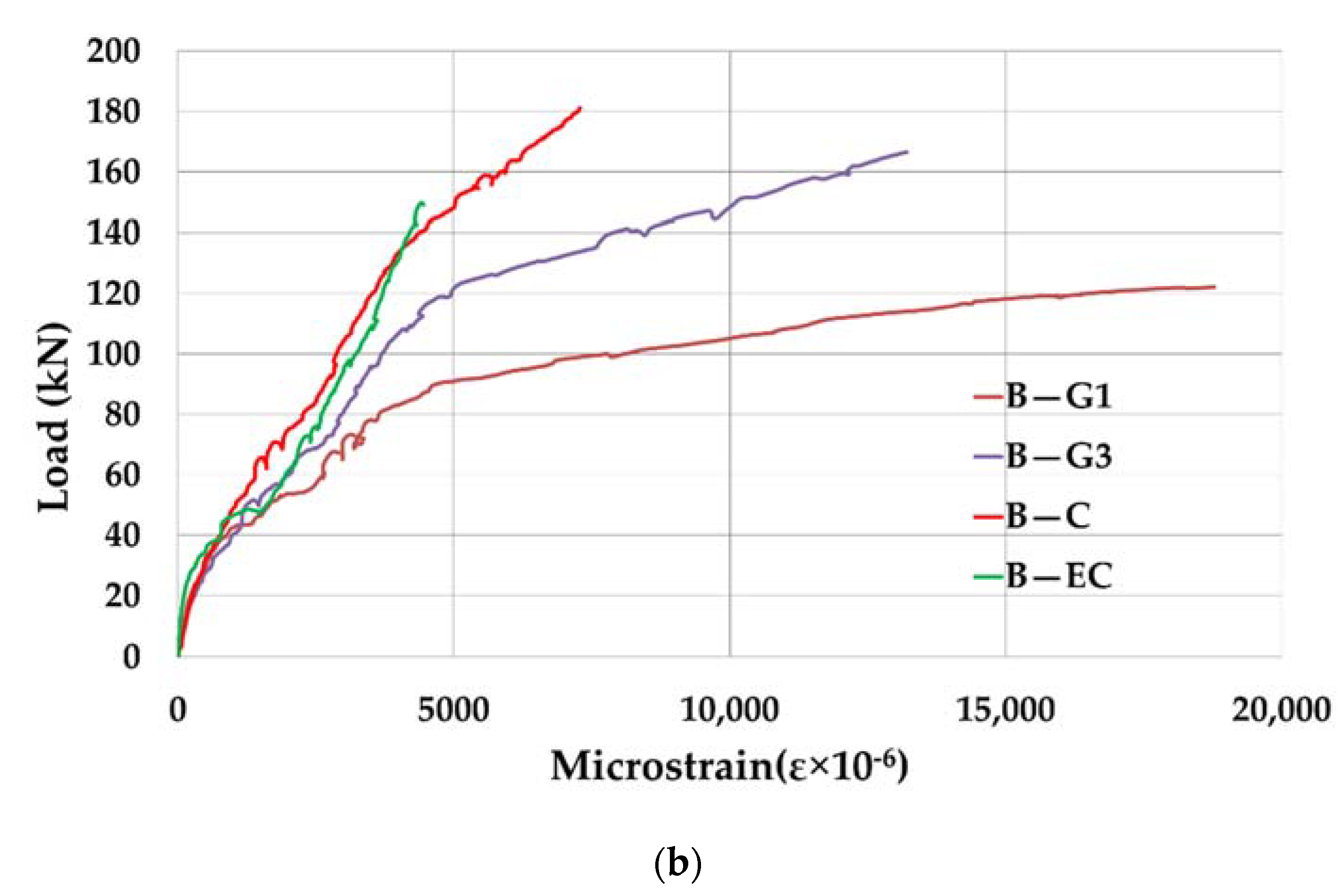
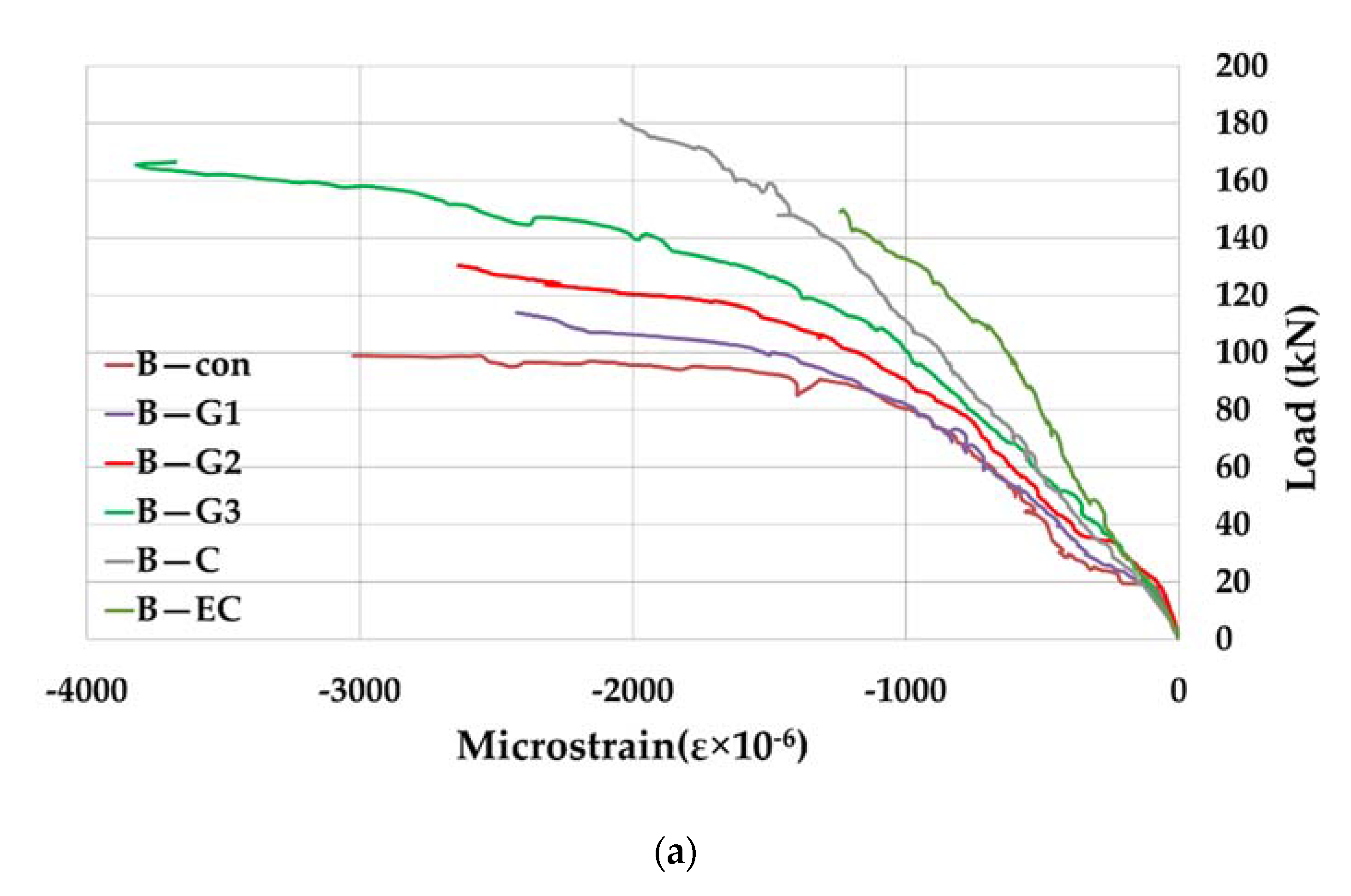
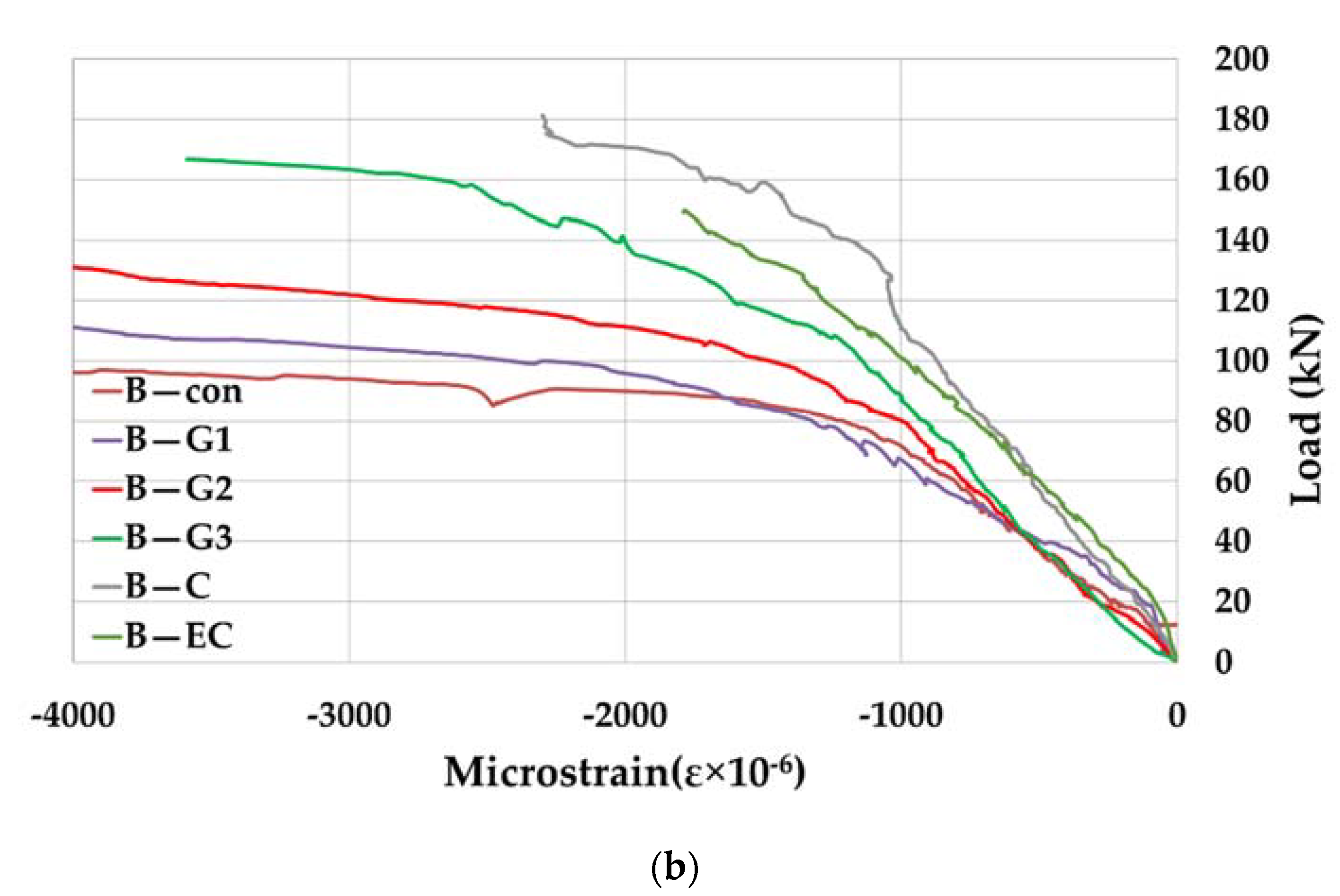
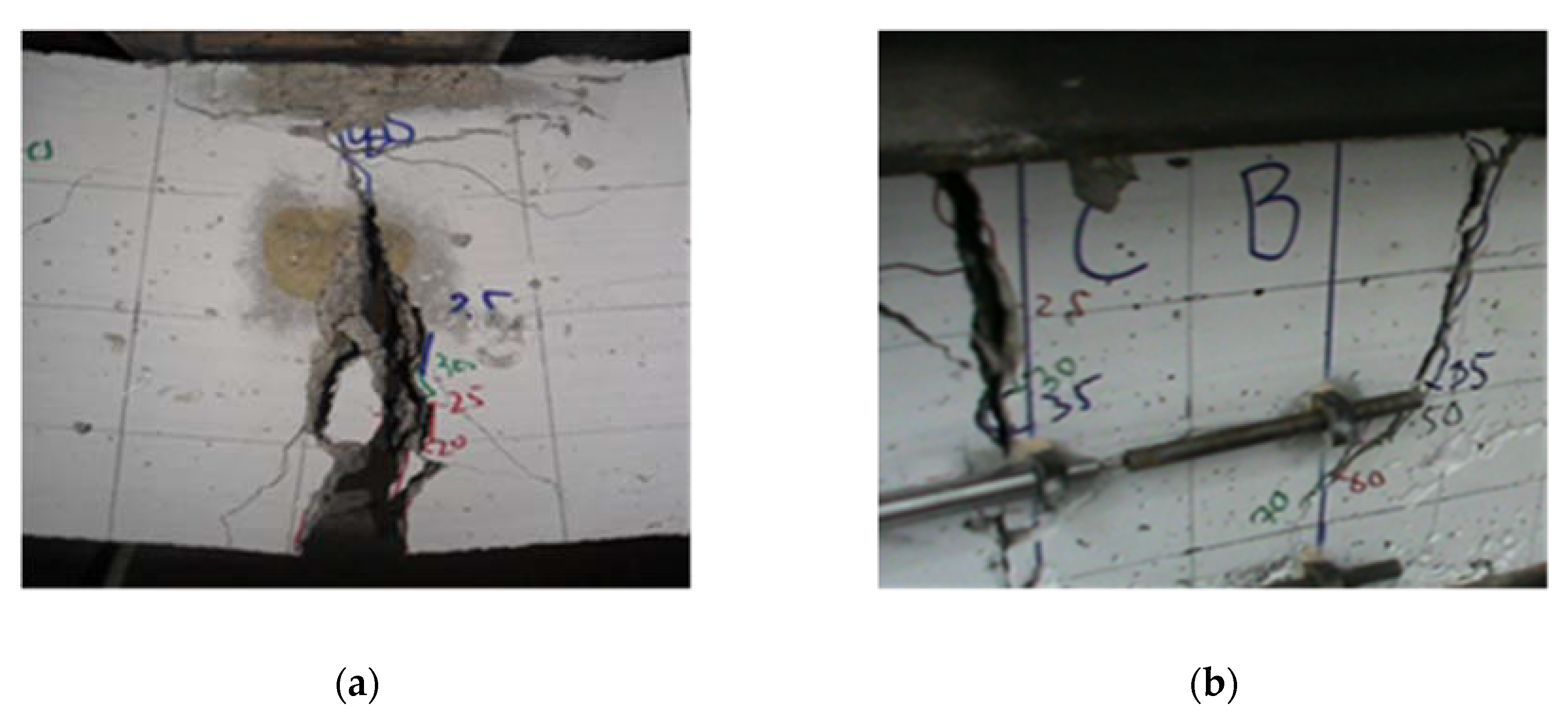
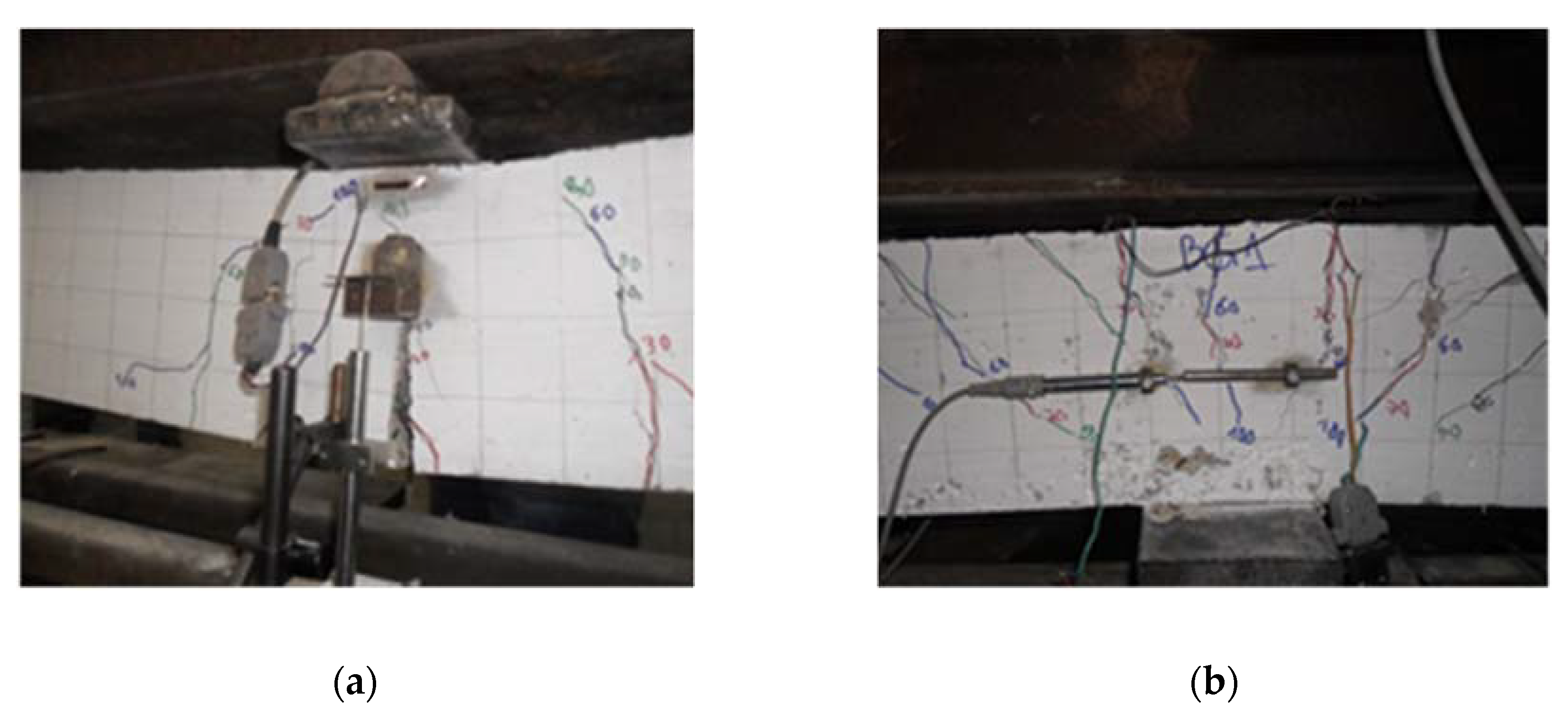
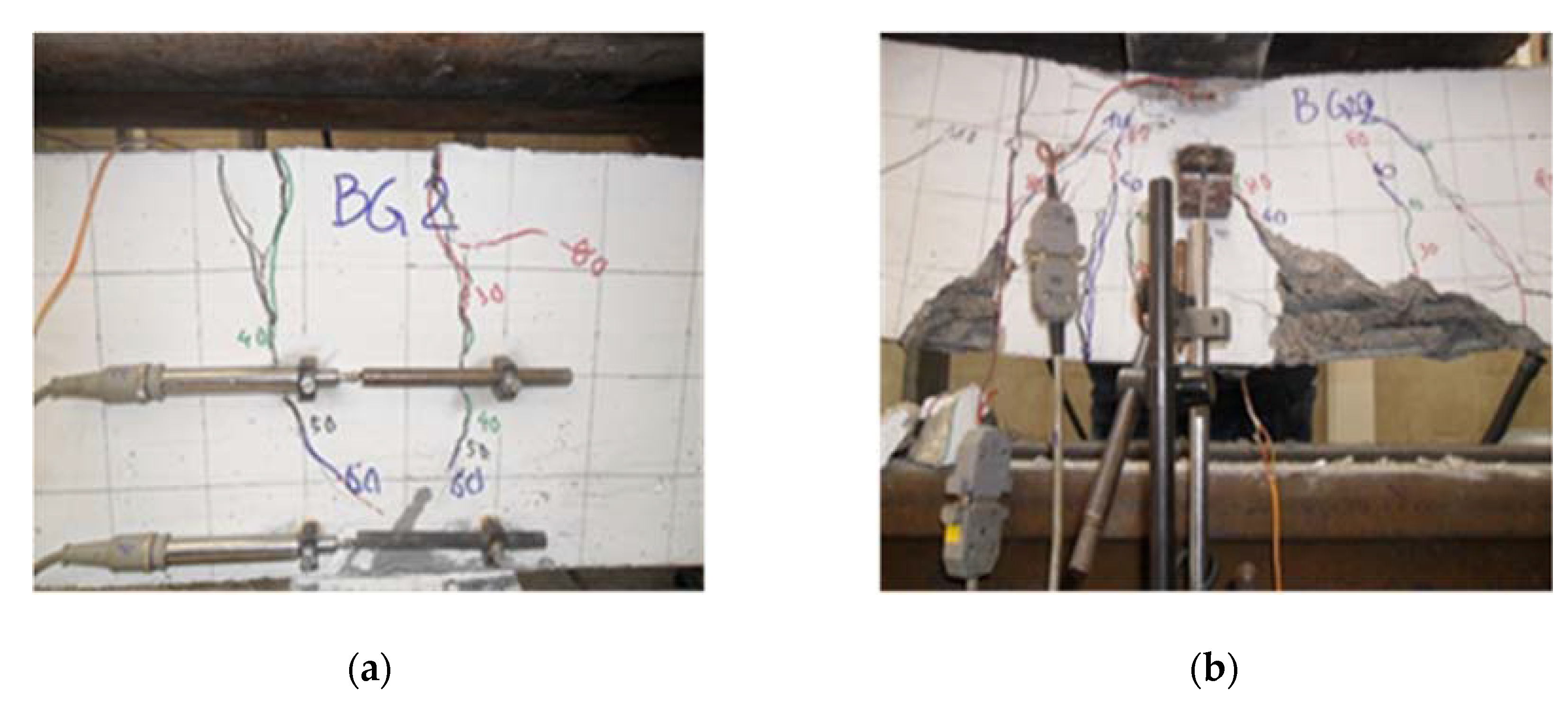
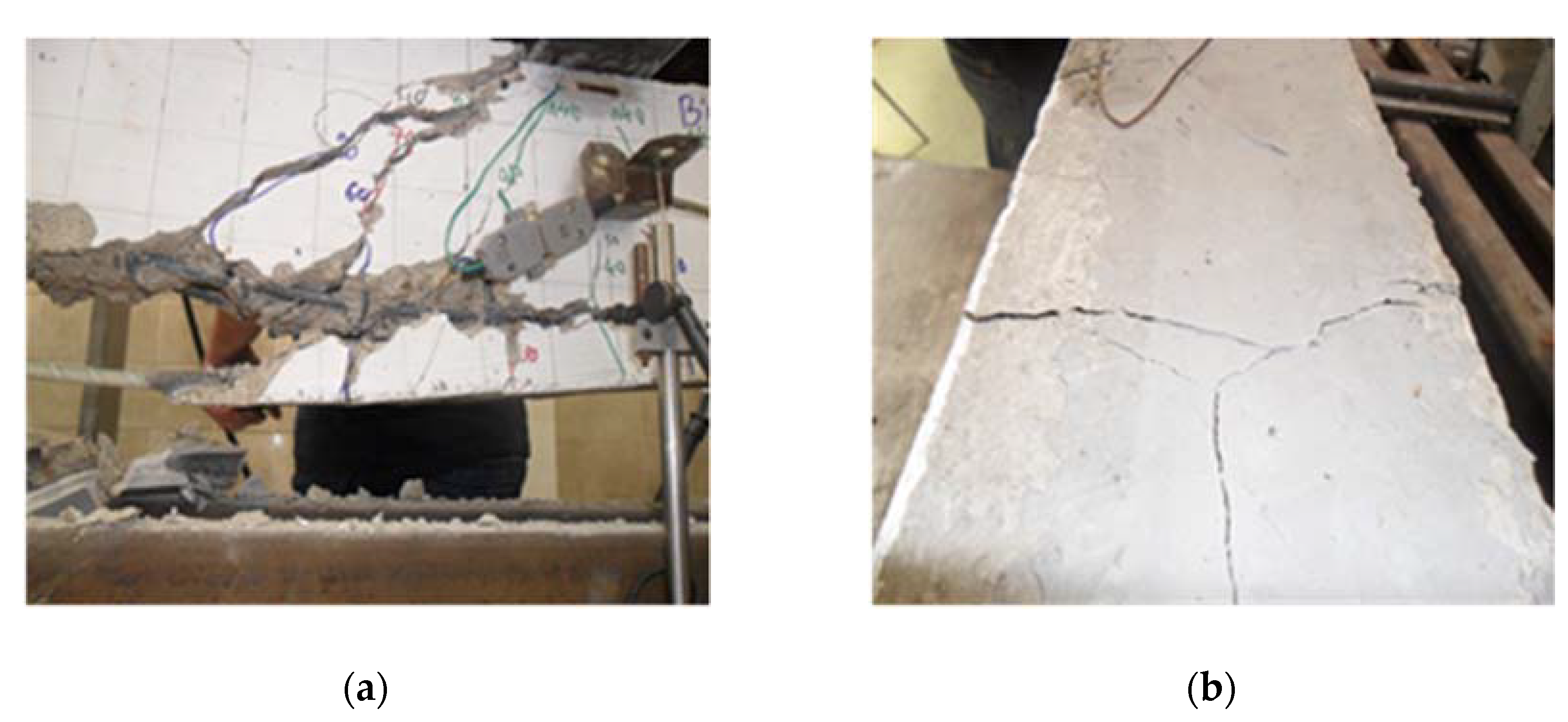
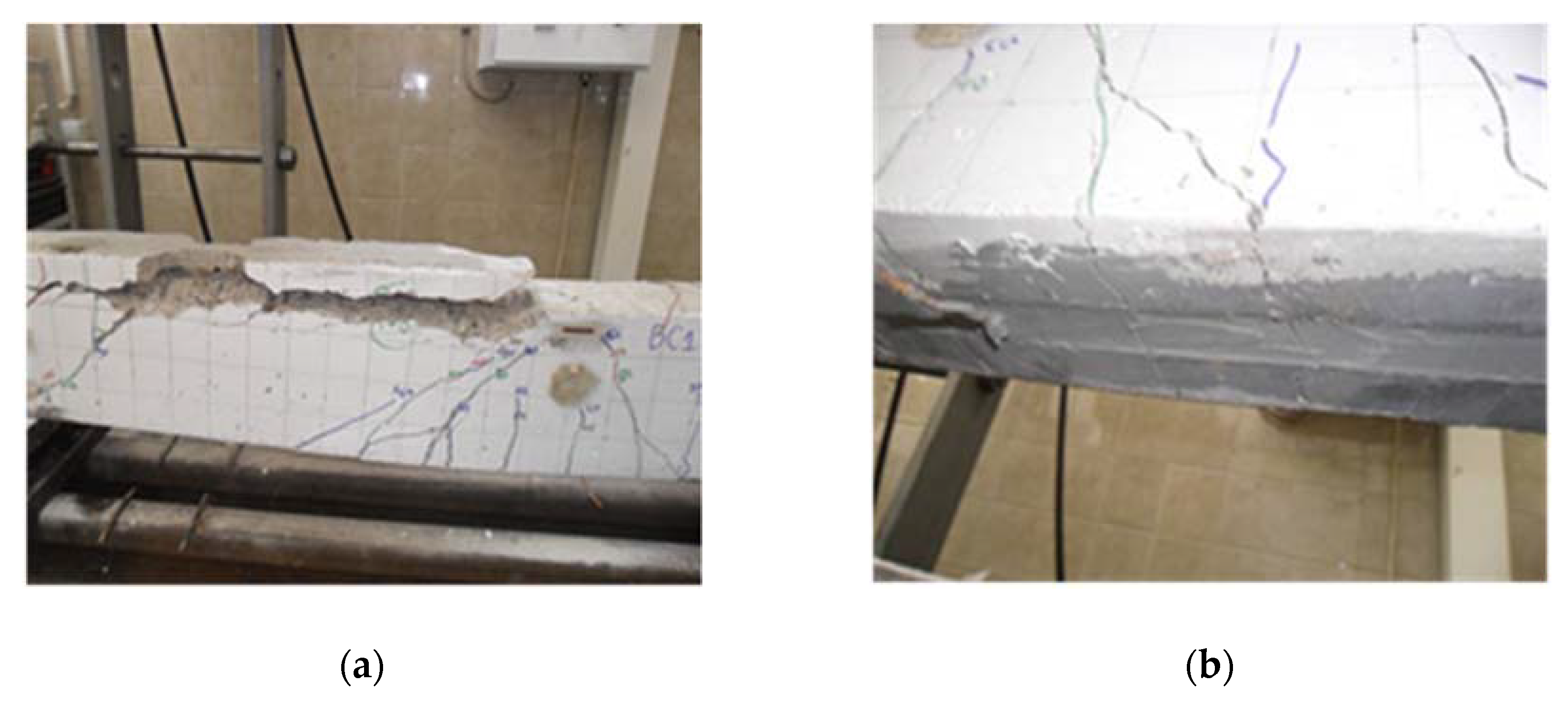
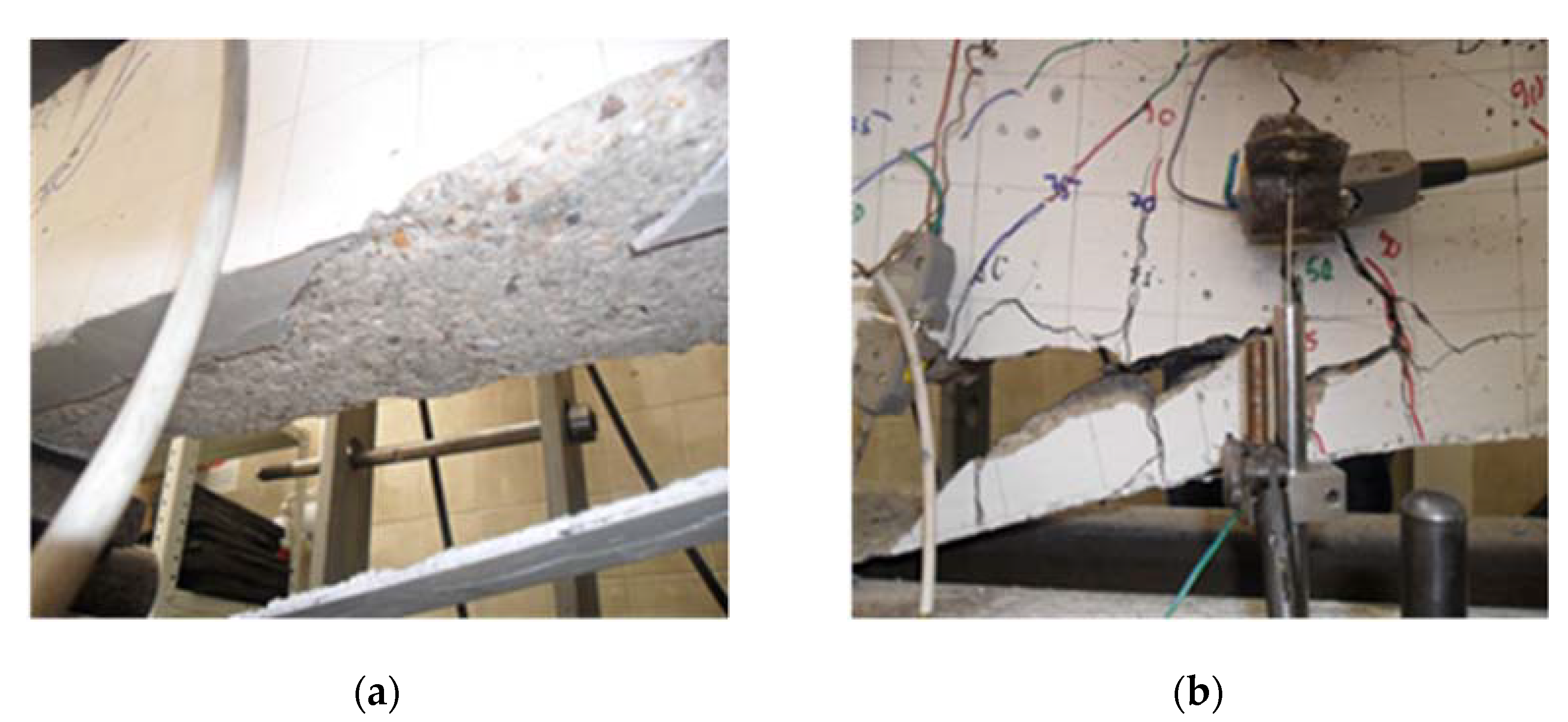
| Characteristics of Cement | Value |
|---|---|
| Setting Time, Min | Start 176, End 226 |
| Density | 3.13 g/cm3 |
| Bulk density in loose state | 930 kg/m3 |
| Bulk density in compacted state | 1515 kg/m3 |
| Tensile strength at 2 days | 6.98 N/mm2 |
| Tensile strength at 28 days | 9.30 N/mm2 |
| Compressive strength at 2 days | 31.33 N/mm2 |
| Compressive strength at 28 days | 55.15 N/mm2 |
| Mass for 1 m3 (kg) | ||
|---|---|---|
| limestone filler | 100.00 | |
| cement | 320.00 | water absorption (%) |
| fraction 0–4 mm | 807.50 | 0.80 |
| fraction 4–8 mm | 380.00 | 0.50 |
| fraction 8–16 mm | 553.00 | 0.40 |
| water | 210.00 | |
| MC Power Flow 1102 additive | 2.10 |
| Density (kg/m3) | Slump-Flow Test D (mm) | t500 (s) | ωc (Water Cement Ratio) |
|---|---|---|---|
| 2305 | 605 | 4.8 | 0.49 |
| Compressive Strength (MPa) | Tensile Strength (MPa) | Modulus of Elasticity (GPa) | |||||
|---|---|---|---|---|---|---|---|
| Secant | Tangent | ||||||
| fc,2 | fc,7 | fc,14 | fc,28 | fct,28 | Ec | Ecm | |
| 12.06 | 18.15 | 24.93 | 28.82 | 3.44 | 25.35 | 24.35 | |
| Standard deviation (σ) | 0.63 | 0.92 | 1.15 | 1.24 | 0.15 | 1.25 | 1.15 |
| Reinforcement | Dimension (mm) | Modulus of Elasticity (GPa) | Ultimate Strain (ε × 10−6) | Yield Strength (MPa) | Tensile Strength (MPa) |
|---|---|---|---|---|---|
| steel | Ø8 | 200.0 | - | 500 | 560 |
| CFRP bar | Ø8 | 148.1 | 13,434 | - | 1940 |
| GFRP bar | Ø10 | 47.0 | 15,635 | - | 735 |
| CFRP tape | 50/1.2 | 165.0 | 17,000 | - | 3100 |
| density | 1.70 kg/dm3 |
| Linear shrinkage | 0% (at +23°) |
| Compressive modulus of elasticity | 6000 MPa |
| Bond strength | >3 MPa |
| Shear strength in strengthening | >35 MPa |
| Bond strength in strengthening | >18 MPa |
| Beam Label | Tensioned Steel Reinforcement | Compressed Concrete | FRP | Deflection | |
|---|---|---|---|---|---|
| Section I | B–con | SG1 | SG4 | - | LVDT1 |
| B–G1 | SG1 | SG4 | - | LVDT1 | |
| B–G2 | SG1 | SG4 | SG6 | LVDT1 | |
| B–G3 | SG1 | SG4 | SG6 | LVDT1 | |
| B–C | SG1 | SG4 | SG6 | LVDT1 | |
| B–EC | SG1 | SG4 | SG6 | LVDT1 | |
| Section III | B–con | SG2 | D1 | - | - |
| B–G1 | SG2 | D1 | SG6 | - | |
| B–G2 | SG2 | D1 | - | - | |
| B–G3 | SG2 | D1 | SG7 | - | |
| B–C | SG2 | D1 | SG7 | - | |
| B–EC | SG2 | D1 | SG7 | - | |
| Section II | B–con | SG3 | SG5 | - | LVDT2 |
| B–G1 | SG3 | SG5 | - | LVDT2 | |
| B–G2 | SG3 | SG5 | SG7 | LVDT2 | |
| B–G3 | SG3 | SG5 | SG8 | LVDT2 | |
| B–C | SG3 | SG5 | SG8 | LVDT2 | |
| B–EC | SG3 | SG5 | SG8 | LVDT2 |
Publisher’s Note: MDPI stays neutral with regard to jurisdictional claims in published maps and institutional affiliations. |
© 2021 by the authors. Licensee MDPI, Basel, Switzerland. This article is an open access article distributed under the terms and conditions of the Creative Commons Attribution (CC BY) license (https://creativecommons.org/licenses/by/4.0/).
Share and Cite
Petrović, Ž.; Milošević, B.; Ranković, S.; Mladenović, B.; Zlatkov, D.; Zorić, A.; Petronijević, P. Experimental Analysis of Continuous Beams Made of Self-Compacting Concrete (Scc) Strengthened with Fiber Reinforced Polymer (Frp) Materials. Appl. Sci. 2021, 11, 4032. https://doi.org/10.3390/app11094032
Petrović Ž, Milošević B, Ranković S, Mladenović B, Zlatkov D, Zorić A, Petronijević P. Experimental Analysis of Continuous Beams Made of Self-Compacting Concrete (Scc) Strengthened with Fiber Reinforced Polymer (Frp) Materials. Applied Sciences. 2021; 11(9):4032. https://doi.org/10.3390/app11094032
Chicago/Turabian StylePetrović, Žarko, Bojan Milošević, Slobodan Ranković, Biljana Mladenović, Dragan Zlatkov, Andrija Zorić, and Predrag Petronijević. 2021. "Experimental Analysis of Continuous Beams Made of Self-Compacting Concrete (Scc) Strengthened with Fiber Reinforced Polymer (Frp) Materials" Applied Sciences 11, no. 9: 4032. https://doi.org/10.3390/app11094032
APA StylePetrović, Ž., Milošević, B., Ranković, S., Mladenović, B., Zlatkov, D., Zorić, A., & Petronijević, P. (2021). Experimental Analysis of Continuous Beams Made of Self-Compacting Concrete (Scc) Strengthened with Fiber Reinforced Polymer (Frp) Materials. Applied Sciences, 11(9), 4032. https://doi.org/10.3390/app11094032











